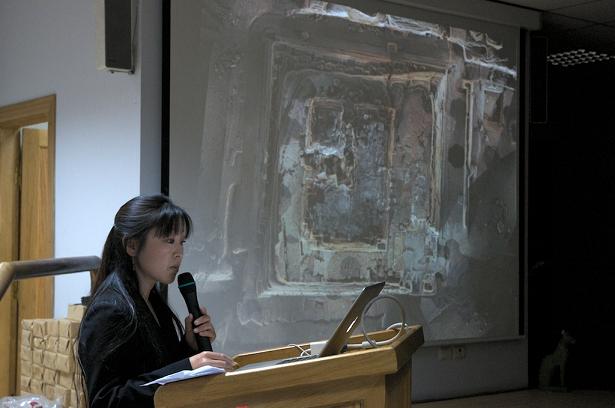Dr. Zahi Hawass gave warm mid-day remarks about the AERA/ARCE Field School to an already packed auditorium at the Supreme Council of Antiquities on Sunday, 15 March. Dr. Hawass’ statement introduced the second half of the fascinating lectures by AERA team leaders and Mark Lehner.

Dr. Zahi Hawass talks about the AERA/ARCE Field School.
Dr. Hawass said that his friendship with Mark “…is one of the most important relationships showing how an Egyptian and foreigner who are highly motivated and educated can work together for good. Mark does this for us.”
He’s very proud of the Egyptian graduates of the school.
Accent on the international
Typically, with AERA’s international composition, the talks were given in a variety of accented English by participants from nine different nationalities, including Egyptians (accented, of course, to my American ears).
A lot of the evidence presented about the pyramid settlement indicates a formally-established, highly-controlled, royally-provisioned city.
Bones
I arrived a little late (I’d been visiting Egyptian friends across Cairo until about 1:00 am), just as osteologist Jessic Kaiser was presenting. Jessica was explaining how the most common pathologies on the Late Period skeletons at Giza are, not surprisingly, stress related injuries from hard work, and some malnutrition (not related to pyramid building, as this is thousands of years later).
Child burials are over-represented in one area of the Late Period cemetery. She explained how the fact that one child with a terrible birth defect survived for about 18 months and was carefully buried, telling us something important about this ancient culture, showing a great concern for the child in the afterlife. It’s interesting that the amulets found in the burials are mostly in the child burials.
It was sweet later to see Jessica get quite emotional over the successful presentation by her former student and current co-instructor, Afaf Wahba. Afaf talked about the methods employed in AERA classes, and the importance of teaching students to think, not just memorize.

AERA Joint Field Director, Mohsen Kamel.
Pots
AERA ceramicist, Dr. Anna Wodzinska, told us that the more than 70 tons of ceramics that AERA has excavated at the Lost City dig site are comprised of more than 1.5 million sherds and complete vessels that date from the Old Kingdom to the Roman period. Bread molds make up 54% of the corpus, mostly found in the bakeries in the non-elite areas of the settlement. Not surprisingly, the elite areas contain better ceramics than non-elite areas.
More bones
AERA Chief Research Officer, Dr. Richard Redding, has examined over 400,000 bone fragments from the Giza dig site. Again, the animal remains give strong indication that the site was provisioned. In other words, animals were not being husbanded in great numbers on the site but were brought in by the royal administration to supply the work force that built the pyramids.

Manami Yahata shows results of AERA’s laser scanning project at KKT and the Step Pyramid.
An interesting note from Emmy Malak’s presentation on objects from the settlement is that the classifications of objects are sometimes hard to determine due to repurposing. As an object wore, it got employed in different ways than that for which it was originally created; is it a pounder or a grinder; or both? There are many beautiful objects, including stone tools, copper needles and fish hooks, gaming pieces, headrests, beads, fishnet weights, and more.
There were so many other high points during the day (see the complete list). Everyone was much relieved after weeks of preparation to have their talks completed. At least they won’t have that to work on at the end of a day of digging and teaching.

Mark Lehner wraps up the day.
Conclusion
Mark Lehner tied the lectures together. He talked about the various disciplines that are represented on the AERA team and how his job is to look at the big picture, trying to discover patterns. What does it mean that a particular area of the dig site has this kind of lithics and that kind of ceramics and a variety of animal bones and a certain kind of structures? What can this tell us about the planning and logistics and execution of living and working at Giza during the age of the pyramids? How do AERA archaeologists essentially start with a garbage dump and make inferences to reconstruct the administration of the 4th Dynasty?
While the patterns at the settlement imply provisioning, it is on such a scale as to have impacted the entire nation of Egypt. Materials and workers were requisitioned and transported to Giza, where they had to be securely stored, controlled, and distributed. As Mark likes to say, “While it is interesting to wonder how the Egyptians built the pyramids, it’s more interesting to look at how the pyramids built Egypt.”
Brian Hunt
Photos: Jason Quinlan
